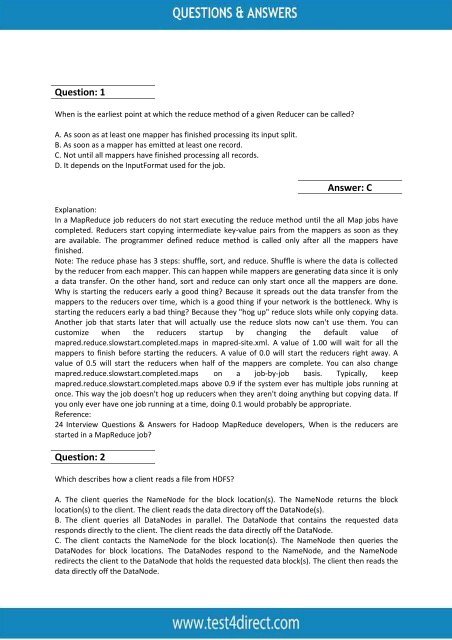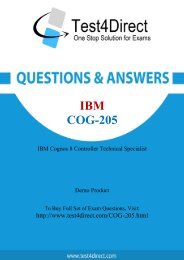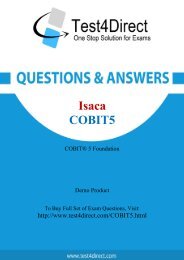Real CCD-410 Exam BrainDumps
Test4Direct provides latest PDF questions of Cloudera CCD-410 exam. You have an opportunity to pass the Cloudera CCD-410 exam in one go. Test4Direct is most accurate source to prepare Cloudera CCD-410 exam as your success will become site’s responsibility after purchasing CCD-410 exam product. There are also lots of discounts and promotion offers that you can avail. Let’s try a free demo http://www.test4direct.com/CCD-410.html
Test4Direct provides latest PDF questions of Cloudera CCD-410 exam. You have an opportunity to pass the Cloudera CCD-410 exam in one go. Test4Direct is most accurate source to prepare Cloudera CCD-410 exam as your success will become site’s responsibility after purchasing CCD-410 exam product. There are also lots of discounts and promotion offers that you can avail. Let’s try a free demo http://www.test4direct.com/CCD-410.html
You also want an ePaper? Increase the reach of your titles
YUMPU automatically turns print PDFs into web optimized ePapers that Google loves.
Question: 1<br />
When is the earliest point at which the reduce method of a given Reducer can be called?<br />
A. As soon as at least one mapper has finished processing its input split.<br />
B. As soon as a mapper has emitted at least one record.<br />
C. Not until all mappers have finished processing all records.<br />
D. It depends on the InputFormat used for the job.<br />
Question: 2<br />
Answer: C<br />
Explanation:<br />
In a MapReduce job reducers do not start executing the reduce method until the all Map jobs have<br />
completed. Reducers start copying intermediate key-value pairs from the mappers as soon as they<br />
are available. The programmer defined reduce method is called only after all the mappers have<br />
finished.<br />
Note: The reduce phase has 3 steps: shuffle, sort, and reduce. Shuffle is where the data is collected<br />
by the reducer from each mapper. This can happen while mappers are generating data since it is only<br />
a data transfer. On the other hand, sort and reduce can only start once all the mappers are done.<br />
Why is starting the reducers early a good thing? Because it spreads out the data transfer from the<br />
mappers to the reducers over time, which is a good thing if your network is the bottleneck. Why is<br />
starting the reducers early a bad thing? Because they "hog up" reduce slots while only copying data.<br />
Another job that starts later that will actually use the reduce slots now can't use them. You can<br />
customize when the reducers startup by changing the default value of<br />
mapred.reduce.slowstart.completed.maps in mapred-site.xml. A value of 1.00 will wait for all the<br />
mappers to finish before starting the reducers. A value of 0.0 will start the reducers right away. A<br />
value of 0.5 will start the reducers when half of the mappers are complete. You can also change<br />
mapred.reduce.slowstart.completed.maps on a job-by-job basis. Typically, keep<br />
mapred.reduce.slowstart.completed.maps above 0.9 if the system ever has multiple jobs running at<br />
once. This way the job doesn't hog up reducers when they aren't doing anything but copying data. If<br />
you only ever have one job running at a time, doing 0.1 would probably be appropriate.<br />
Reference:<br />
24 Interview Questions & Answers for Hadoop MapReduce developers, When is the reducers are<br />
started in a MapReduce job?<br />
Which describes how a client reads a file from HDFS?<br />
A. The client queries the NameNode for the block location(s). The NameNode returns the block<br />
location(s) to the client. The client reads the data directory off the DataNode(s).<br />
B. The client queries all DataNodes in parallel. The DataNode that contains the requested data<br />
responds directly to the client. The client reads the data directly off the DataNode.<br />
C. The client contacts the NameNode for the block location(s). The NameNode then queries the<br />
DataNodes for block locations. The DataNodes respond to the NameNode, and the NameNode<br />
redirects the client to the DataNode that holds the requested data block(s). The client then reads the<br />
data directly off the DataNode.
















